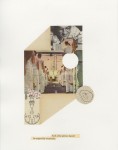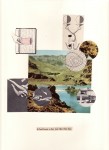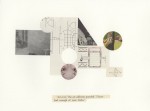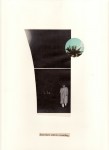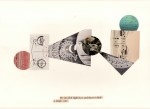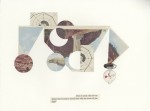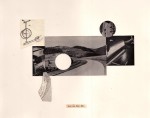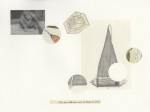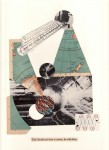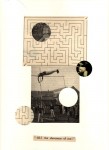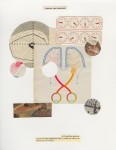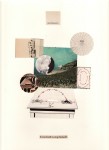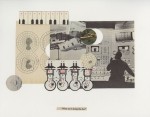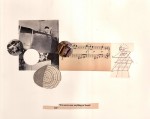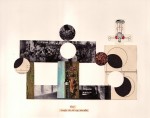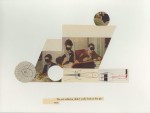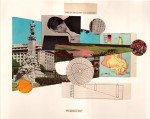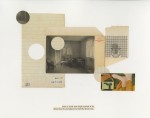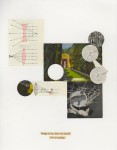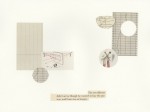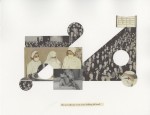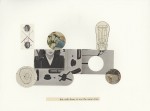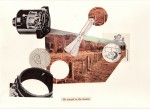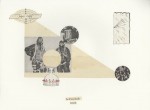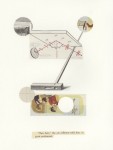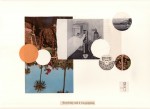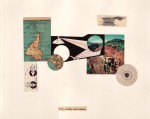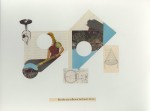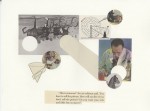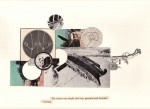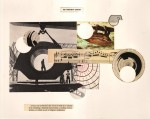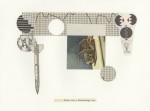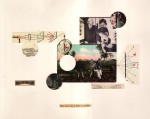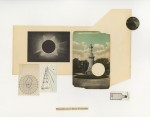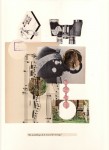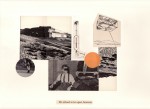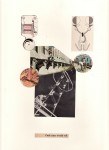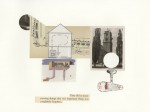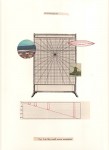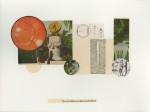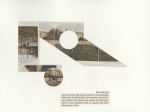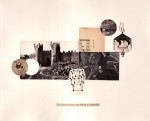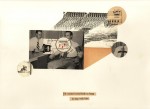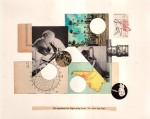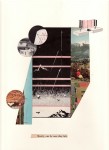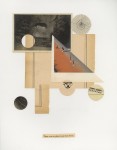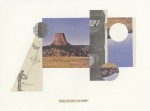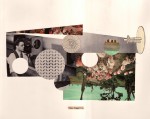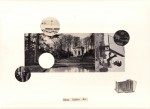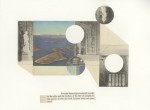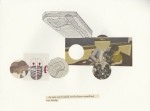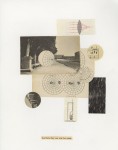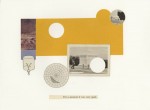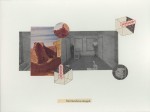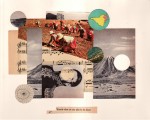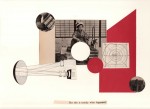The Arlington Heights Suite
The Arlington Heights Suite is a series of collages initiated in 2008, incorporating images and texts from vintage and
discarded old books and textbooks.
The exhibition project of the Arlington Heights Suite consists of exhibiting the entirety
of the works made to this date. As of April 2023 there are 20,100
works in the series. When the project is to be exhibited, all collages are to be framed and hung salon-style.
—
In 2005, I temporarily left the museum world in order to complete the longest journey of my life, and what I thought would be my most extensive art work, consisting of driving from Alaska to Chile organizing a range of activist actions, workshops and performances at various stops. My return, in September of 2006, felt like the appropriate moment to start a new chapter for my work. And yet, the experience of having crossed the Americas was so overwhelming that I found myself paralyzed.
I had a great deal to process, and probably needed to overcome a PTSD condition that was developed over the course of those four months of the perilous journey. Three months after my return, I still found myself completely unable to make art, only checking the news incessantly in the morning and living in a way that felt more like filling in the time, rather than using it.
Being without a job, and with the scarce funds left from a grant that had supported my trip, I arrived in Chicago (where my mother and sisters live) to spend Christmas with my family, as has been the tradition since my parents and myself emigrated there. Given that I had little funds to purchase gifts for friends and family, I opted to make collages (that year, as I recall, I had seen a collage at a Whitney Biennial fundraiser, made by an artist colleague, and I recall thinking: “I could do much better than that”).
I went into a used bookstore in Clark Street in Chicago, and purchased a few used textbooks that dealt with Latin America. I got a few more at Penn Dutchman Antiques (a store in Lincoln Square that closed four years ago). I also bought a 1960s high school textbook on physics and a 1930s electrician’s handbook with fascinating diagrams; all for probably less than $5.
With that, I sat to make collages.
I somehow had the idea of cutting out phrases from the books that I could use to describe, even in a metaphorical way, aspects of the experiences that I had during my journey, or ideas that had gone through my head at the time:
“Tradition existed before that.”
“It followed its own nature, and worked to fulfill its own requirements.”
“The Wanderer’s Farewell”
I thought I would make about 10 of them.
But the practice became addictive. It was hard to stop. It also became a sort of retroactive diary of my journey. Titled the Panamerican Suite, these works form a group of about 200 collages.
Sometime in 2007, my mother moved to Arlington Heights, a northwest suburb of Chicago, located some 25 miles from the center of the city. It is mainly known for its racetrack, created in the early XXth Century. I liked the poetic name of the suburb, which I believe reminded me of the experience of reading Wuthering Heights when I was 17. Other than that, it is a typical Chicago suburb; a quiet, harmonious non-place. I learned to love it, too, in my brief family stays there; to visit its stores that could be anywhere in the US, and to be in that specific apartment of my mother, which is a XIXth century European-Mexican apartment transplanted to the middle of that context. Her apartment is some kind of sanctuary, of relative mausoleum, packed as it is with photographs and portraits of us when we were young and of our dead relatives.
It was in that apartment, during brief Chicago visits, and after having satisfied that original need to debrief from my Pan-American trip, that I still felt the need to continue making collages. Making them was, and continues to be, an incredibly liberating experience. It was also a way to work relatively fast — something that brought me back to the times when I used to have access to a print shop in Chicago and would produce print editions, something that I always missed but was unable to take on in comfortable conditions.
Thus I started making the first collages of The Arlington Heights Suite. Like the place where the series was initiated, the collages had an ancillary quality: outside of the main thing I was working on. At the same time, they became a way for me to communicate what I was feeling at the time. These collages became, without me fully realizing it, a diaristic practice. It was also liberating to use found images and texts to narrate what was happening at that very moment, knowing that no one would really know, other than me, what it was —and that it never would matter anyway, because art, as specific as it can be, in a sense it never truly reveals the mind of the artist.
The use of captions and titles in these collages respond to a variety of interests. One of them relates to constrained writing techniques from the 60s, and another to conceptual poetry.
There is also something very specifically related to Chicago in the texts and images. Some of the works that have remained with me the longest since I was an art student in Chicago were the paintings and drawings of Jim Nutt, made in the 60s, 70s and 80s: “A Forward Promise”,
“Blaah (Going Right By)”, “Why Did He Do It?”, which are titles that seem to be extracted from random phrases, comments, and headlines that one would collect from publications or the street. The powerful psychological incorporation of these phrases, and the way they are seemingly disconnected from the images drawn from pop culture are a direct nod to the legacy of the Imagists (here I am thinking of imagist artists like Ray Yoshida, who was my teacher, as well as Roger Brown and Karl Wirsum). But these series of collages also had a strong theatrical influence. I heard somewhere that to be a good playwright, you need to sit in a bus or subway and write down phrases that you hear in order to capture the true colloquial rhythm of lived language, which is very different from the written one.
To this day, one decade later, I have made close to 3000 works, and haven’t been able to stop. It has become a new journey for me, albeit one on paper. I read that Pablo Picasso produced 40,000 works in his lifetime. I calculated that I might be able to reach that number in about 40 years should I be able to apply myself to this task and be lucky enough to reach old age. I also decided that this project must be exhibited in its totality for the following reasons:
The first is not so much a reason, but an image from the film Synecdoche, New York–one in which the main character (played by Philip Seymour Hoffman), a theater director, is walking around the sprawling warehouse of his magnum opus, one which is mimetic of his own life, one which summarizes his entire life.
Around the time when I started thinking about exhibiting the Arlington Heights Suite last year, I was at a meeting in my museum where a curator talked about the difficulty of selecting the most representative works of an artist for a retrospective exhibition he was working on. I concluded that I wanted to take an anti-curatorial approach with the Arlington Heights suite: I want all the works included in any exhibition done of them. I am against selection and against the traditional museum experience. I am against displaying anything other than the actual and exact record that currently exists. For the Arlington Heights Suite represents my life; even while it cannot summarize every minute of it, it does represent thousands of its moments and captures my feelings more than anything else I have ever made. It is obviously highly unlikely that any single viewer would invest the time to see and read every single one of these works, but that is completely besides the point, because every art viewing experience is always fragmentary, forgettable, and imperfect. The curating thus would be left to chance, not to anything else.
The Arlington Heights Suite, I also concluded, in all the array of phrases and images, will be the basis of two more outcomes. One will be a published work, a novel in the surrealist tradition of Max Ernst, and a performance–one that I have already started to develop with my actors/collaborators and which I foresee developing over the course of the next decades.
New York, January 2018
Tags: Collage, Counterpoint, Language, Memory, Nonsense
